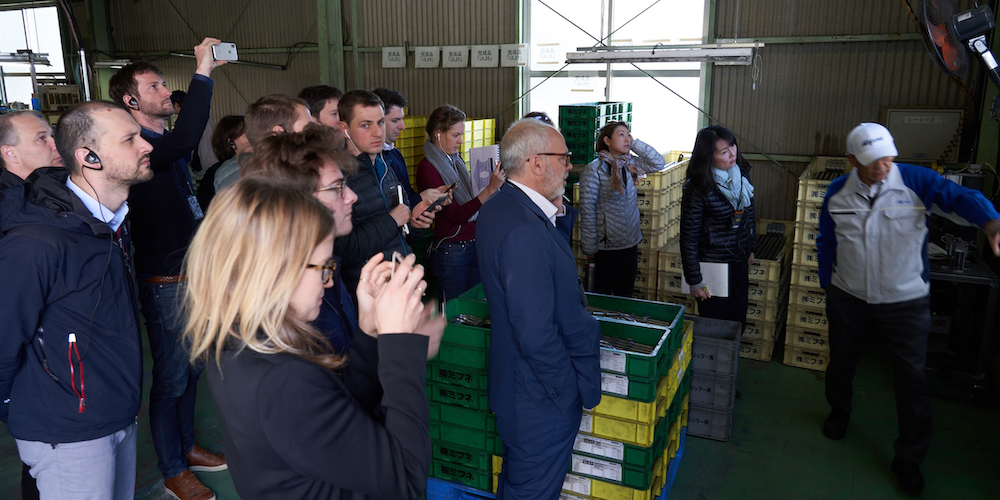
Enabling improvement across our healthcare system
CASE STUDY – How do you give hundreds of primary care units the tools and knowledge they need to make improvements? The Catalan Health Service found the solution in hoshin kanri.
Words: Jeroni Salabert Carreras, Clara Pladevall Viladecans and Daniel Algar Martínez
The Catalan Health Service (CatSalut) provides public health care to the 7.7 million citizens of the Spanish region of Catalonia. The project described in this article focuses on improving processes and outcomes of the 373 primary care units of the region (Equipos de Atención Primaria – EAP – in Spanish).
Primary care is under constant strain – a situation made worse by the pandemic – and what we are trying to do is to provide the teams on the ground the support they need to find solutions to age-old problems.
From the beginning, it was clear this wouldn’t be an easy feat. How do you find solutions to problems that are common to 373 organizations while considering their specific needs (each EAP operates in a unique environment, from the busy neighborhoods of Barcelona to the rural communities of the Pyrenees)? How do you standardize the care Catalan citizens receive, independently of where they live? How do you move from a traditional model in which solutions are cascaded from the top of the organization to one where they stem from the improvement work of each unit?
In 2020, Catsalut decided to initiate a project to improve primary care and to rely on the powerful lean practice of hoshin kanri for its deployment. The first step was establishing a team of process engineers, with the three of us supporting the project centrally and six others assisting units across Catalonia’s nine health regions. Consulting firm Essentia Health Management is helping us in the strategic scoping of the project and its deployment (some of us previously worked in Barcelona’s Vall d’Hebron hospital, a pioneering healthcare organization that has done great work with hoshin.) Through PDCA-based coaching taking place during standard sessions, we are accompanying each unit as they work to improve their processes. So far, over 2,000 primary care workers have been involved in the lean training (provided by Instituto Lean Management) and improvement projects, of which we currently have 358. We expect the compounded effect of these projects to be very significant for the health system as a whole.
LAYING THE GROUNDWORK – THE “PLAN” PHASE
Lean Thinking is now widespread across the Catalan healthcare sector, which means there is a lot of capability available out there. Some of us had previous lean experience, having handled large multi-functional teams as part of the hoshin process.
Our first step within CatSalut was to fully understand the nature of the work of a primary care unit (despite each unit’s idiosyncrasies, the primary care process is the same everywhere – or at least it should be) and develop an idea of what the “future state” looks like. To do this, we carefully observed several units, gathering as much information as we could to understand where we were and what we wanted to achieve.
Before we could get to a point where each primary care unit in Catalonia is aware of the contribution that they are giving to the overall success of the health system, we needed to clarify our plan of attack. With countless ongoing projects (most of them, initiatives from top management) and a staggering 2,000+ KPIs to measure team performance, it was clear we had a lot of housekeeping to do.
With hoshin, we aimed to bring order to the improvement work that was already in place while allowing for new projects coming from the front line to be initiated.
From a strategic standpoint, we decided to stick to the areas we were already addressing – reception and accessibility, resolution, and continuity of care (which represent in essence the path of a patient from the moment they enter the unit to the moment they leave). We realized that our strategic intent would be easier to communicate to the organization using these three focus areas, rather than the traditional SQCD approach (especially because it turned out that most of the projects focused on either Quality or Delivery).
Next, we had to drastically reduce the number of indicators we tracked and bring order to our portfolio of projects. Looking at the strategic areas we had identified, we tried to define what we meant by “success” for the following year, and based on that, we simplified and narrowed down the list of KPIs to just 11. This was critical in ensuring everyone shares a clear understanding of what success looks like and in making it much easier to track progress.
The initial version of our hoshin board told us that people were still lacking a big-picture view and that many projects didn’t really contribute to the improvement of outcomes in the three strategic areas. Some would help us close the gap, but others wouldn’t. We then made an inventory of the projects that were already in execution and of those we wanted to kick off. The key word at this stage was “prioritizing”. Using post-it notes on a Value Stream Map, we then visualized under which of the three strategic areas each project fell. In a bid to simplify, we only kept those projects that would have a direct impact on the three strategic areas, suspending those that didn’t and combining those that appeared to be complementary.
The 11 KPIs we had identified were instrumental in clearly defining success and made it clear to everyone what we wanted to achieve in 2022. From there, it was a matter of cascading those KPIs to the health regions, to see how each of them could contribute to the overall objectives and through which projects.
At the beginning of our initiative, we created a multi-functional team of experts (in primary care, technology, citizen experience, healthcare staff, and KPIs), who were assigned projects they would have to facilitate. This was a very important step because it ensured accountability.
Another critical element for the success of our plan was the introduction of A3-like cards on which we summarized the context, needs, objectives, and action plan for each project. Now that they had a clear view of the main characteristics of their projects and of the actions they took responsibility for in 2022, people started to have more focused discussions during our review sessions.
This was the P in our PDCA, which took around four months. With a final version of the board and a working system to use it, we were now able to start thinking about deployment and governance. Our first session was in January this year.
DEPLOYMENT STARTS – THE “DO” PHASE
The deployment happens in cycles, engaging more and more primary care units each time. From the few units we had observed as part of our pilot, we reached out to 30, while we are now engaging with 60 at a time. This was our way of challenging each region and each unit to think about their work.
For the most part, people in the primary care units didn’t have any previous lean knowledge, which is why our deployment model is based on cycles of ten sessions. The first four focus on introducing lean tools and techniques (with the support of Instituto Lean Management) and the rest on facilitating localized improvement projects. People participating in these sessions are mainly medical, nursing, administrative staff, and managers of the units.
Best practices were being identified as people started to make improvements, and we thought it was important to record them in a matrix that can be shared with the rest of the organization. During our sessions, as we assess the progress on a project and notice that a solution is having an impact on the KPIs, we document it. This makes knowledge available to other primary care units, which now won’t have to “reinvent the wheel” every time they face a problem that was already tackled successfully elsewhere.
For the first time, with this system, we had a crystal-clear understanding of what each EAP in Catalonia had to improve. In our mind, this is the greatest contribution of hoshin: making people aware of how their work impacts the overall performance of the organization. Indeed, the territorial deployment was critical to motivating the teams.
For our hoshin reviews, we replicated the same structure of meetings we had established in previous experiences, which clarified what had to happen before, during and after a review session, as well as who should do what and by when. Everyone knew what to work on at all times.
We also set up a space to work in greater detail with the project leaders from the multi-functional team responsible for the execution of projects. These monthly individual sessions are opportunities to coach project leaders using the project cards Any obstacle or problems highlighted in the individual meetings turns into a red card and is flagged up during the all-hands meeting for follow-up.
We were coming from a process of revision of projects based on long, unfocused discussions and PowerPoint presentations. With hoshin, we highlighted the need to focus our sessions on what didn’t work, to quickly make everyone aware of what was going on and to attack pain points as they appeared.
ASSESSING PROGRESS – THE “CHECK” PHASE
When we started the review process, we realized it was hard for people not to get into too much detail in their discussion. They seemed to prefer to talk about the content of a project rather than specify what needs to happen to unblock a certain situation or solve a problem. We had to challenge them to be more specific.
For every problem, we must come up with a countermeasure. In the first sessions, people talked a lot (which is always a good sign), but often didn’t commit to an action plan. We’d typically found out about problems at the following meeting. So, to make people more proactive in problem solving, we have begun to anticipate future risks and turn the cards red even when the problem hasn’t arisen yet.
When it came to explaining a problem, people also had to learn to take responsibility for a solution. We have found that the presence of senior leaders in the sessions helps to unblock situations where their action is needed and to reach solutions faster.
ADJUSTMENTS NEEDED? – THE “ACT” PHASE
This is a continuous improvement process. Each session gives us new things to improve. During the first session, for example, we realized that many people were struggling to follow our action-by-action review. This led us to change our approach and begin doing our follow-up on each of three strategic areas instead, allowing us to review all projects in one session using the same visual tool (the cards, the information they contain being put on the hoshin board as well). It is very valuable for people to have this big-picture view and to see their work reflected in the organizational KPIs.
We are seeing more participation from people these days. At the last review, everyone was very active. They are starting to know the content of each project and are more willing to talk about problems.
We are now in the process of trying to get people from the different departments involved to “own” the board. Right now, they understand how they work and like them, but we are still struggling to have them use the boards outside of the meetings to regularly update the status of projects. We are also helping people to see the importance of having an action plan coming out of each review session, with a clear deadline and owner.
With the pandemic, we couldn’t meet in person, of course, and that could have led to a drop in commitment. The solution was the introduction of Miro as our main tool for digital communication: with some sessions still carried out online, this platform is proving extremely useful in maintaining the interaction going. It is certainly much better than simply projecting the hoshin board on a screen and having people stare at it for the entire duration of the meeting.
AN EXAMPLE
We’d like to share the example of a project that, we think, beautifully illustrates the benefits of hoshin and the importance of talking to staff to make them question their way of working. When our initiative began, we worked with two primary care units on the way sick leave is handled. Until now, primary care was responsible for all sick leave documentation and hospitals in Catalonia were not able to issue it to hospitalized patients. To retrieve it, someone (typically a relative) has to go to the primary care unit instead. This is a heavily bureaucratic and un-agile process that creates an unnecessary point of contact that doesn’t even require the primary care provider. Our primary care units battled with this problem for years and this change is something they really wanted.
As part of our improvement project, we involved several organizations in discussions and eventually developed an App that allows hospitals to issue sick leave documentation themselves. We trialed it in a specific area of Catalonia and it worked so well that we are already extending it to the rest of the region. It’s being deployed this year and our plan is to reach all hospitals by the end of 2022. To give you an idea of the benefits, this improvement will mean between 180,000 and 324,000 less visits to our primary care units every year, equivalent to the annual consultation capacity of 70 physicians. And that’s only one project!
WHAT WE LEARNED
This is a complete turnaround of our strategy deployment. It is hard work, but we can already see it’s working very well. It was clearly the right choice to start by reducing our “inventory” of projects. We had too many going on when we started, and that simplification exercise proved crucial.
The same is true about facilitating collaboration among departments and rallying people around shared objectives: we find that having all the improvement opportunities that come from the front line appear on the strategic board makes the hoshin process self-sustaining. It also encourages teamwork, allowing us to look at a problem from different perspectives and then find a solution.
Along the way, we also learned the value of patience. Having monthly meetings can give the impression of going slow at times, but it’s important to give everyone the time to internalize this new process and truly understand how it works. The system is easy enough to grasp, but its implications on the organization are not. As more and more people get it, though, we see increased engagement and change across the network.
THE COACHES COMMENT
By (from left to right) Néstor Gavilan, Instituto Lean Management, and Anna Ochoa, Marc Sales Coll and Júlia Soler from Essentia

Change can be hard to attain in a large and traditional public organization, but with discipline and perseverance these brave leaders are making great inroads. The team was able to strike a balance between achieving organizational impact and cultural change, leveraging reflection and their coaching skills to empower people across the network of EAPs to own problems and the solutions to those problems.
The team has understood how lean improvements have to connect with business results. For CatSalut, observing KPI trends and clearly defining objectives and gaps was critical in ensuring the methodology leads to the expected results. This is not magic, it’s just an example of how powerful hoshin is. By rationalizing the tracking of KPIs, working on both organization-wide and local projects, and developing a culture of prevention (a “gap culture”, so to speak), this team is bringing structure to improvement within CatSalut. We look forward to continuing to support them in this journey and we are eager to see what’s next for this organization.
THE AUTHORS

Read more


FEATURE – Digital organizations are starting to recognize that Toyota’s unique approach can show them the way forward, just like it does “traditional” organizations. Here, we hear from a few startup CEOs following their trip to Japan.


FEATURE – In this article, we learn how a simple andon system and lean problem solving helped Theodo move past some of the most common obstacles that Agile alone can’t overcome.


INTERVIEW – What is the secret to Toyota’s ability to engage people in continuous improvement? Tracey and Ernie Richardson look back at their time with the company and tell us.


WOMACK’S YOKOTEN – In his first column of 2018, the author looks at one of the most talked about companies in the world, Tesla, from a lean point of view.

